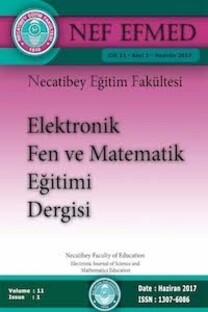Relative Abstract Nature of the Three Core Science Subjects at the Senior Secondary Level in Nigeria as Exemplified by Classroom Interaction Patterns
abstract
Relative Abstract Nature of the Three Core Science Subjects at the Senior Secondary Level in Nigeria as Exemplified by Classroom Interaction Patterns
abstract, Classroom interaction, cognitive ability, cognitive demand, motivation, teacher talk, student talk concrete,
___
- Achor, E E & Orji, B C (2009). Level of students’ motivation in classroom interactions in Integrated Science. Journal of Research in Curriculum and Teaching, 4(1), 294-303.
- Achor, E E (2004). The relationship between curriculum demands and physics achievement of senior secondary school students in Kogi State. Journal of the National Association of Science, Humanities and Education Research, 2(1), 20-26.
- Achor, E E (2003). Cognitive correlates of physics achievement of some Nigeria senior secondary students. Journal of Science Teachers Association of Nigeria, 38(1&2), 10-15.
- Anwukah, T. G. (1990). An after use reflection on the observation technique of interaction analysis, procedure and limitations. International Journal of Education Research, 4, 6-123.
- Chauhan, S.S. (1979). Innovations in teaching learning process. New Delhi: Vilas publishingHouse.
- Flander, N. A. (1970). Analyzing teacher behavior. Addison-Wesly: Reading Mass. FRN (2004). National policy on education. Yaba, Lagos- Nigeria: NERDC press.
- Johnson, D. W. & Johnson, R. T. (2000). Cooperative learning method. University of Minnesota, http://www.co-operation.org. Retrieved 22/05/09.
- Piaget, J. (1970). Piaget theory. In P.H. Musen (Ed.): Garnichael’s manual of child psychology (703-732). New York: Wiley.
- Prosser, M. (1983). Relationship between the cognitive abilities of a group of tertiary physics students and the cognitive requirements of their textbooks. Science Education, 67(1),075-083.
- Shayer, M & Adey, P (1981). Towards a science of science teaching: Cognitive development and curriculum demand. London: Oxford Pub.
- Shuaibu, A.A.M & Iroegbu, N. (2003). A study of the relationship between parents and teachers’ motivational support and secondary school students’ achievement in science.
- Jos Journal of Education, Vol.6, No.2, pp.114-121.
- Udoh, A. O. (2008). An analysis of classroom interaction of senior secondary school chemistry teachers in Ikot Ekpene Local Government Area of Akwa Ibom State Nigeria.
- Journal of Science Teachers Association of Nigeria, 43(1&2), 16-22.
- Vigotsky, L. S. (1978). Mind in society: The development of higher psychological processes. Cambridge: Harvard University Pub.
- ISSN: 1307-6086
- Yayın Aralığı: 2
- Başlangıç: 2007
- Yayıncı: Balıkesir Üniv. Necatibey Eğitim Fak.
Revize Edilmiş Matematik Kaygısı Değerlendirme Ölçeği: Doğrulayıcı Faktör Analizi Çalışması
AHMET AKIN, N. İzzet KURBANOĞLU, Mithat TAKUNYACI
Brousseau’nun Matematiksel Öğrenme Ortamları Kuramı ve Adidaktik Ortamın Bir Uygulaması
SELAHATTİN ARSLAN, DEMET BARAN BULUT, SAMET OKUMUŞ
Matematiksel Kanıt Yapmaya Yönelik Görüş Ölçeği: Geçerlik ve Güvenirlik Çalışması
TUBA AYDOĞDU İSKENDEROĞLU, Adnan BAKİ, MEHMET PALANCI
Öğretim Materyalleri Motivasyon Anketinin Türkçeye Uyarlanması: Güvenirlik ve Geçerlik Çalışması
Öğrenme ve Öğretme Stillerinin 7. Sınıf Öğrencilerinin Matematik Başarısı Üzerine Etkisi
Fatma ŞENTÜRK, Nazlı Yıldız İKİKARDEŞ
İlköğretim Fen ve Teknoloji Programında Yer Alan Afet Eğitimi Konularına İlişkin Öğretmen Görüşleri
